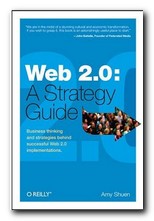exploiting the technology and protecting the enterprise
This is a guide to blogging and social media with a difference. It’s aimed at professionals in business who might not have thought of using such communication techniques before. In fact it’s written by people with a background in law – which doesn’t at first seem like a zappy, media-conscious line of work to be in. But the first half of the book explains how blogs work; it outlines the plusses and minuses of blogging; shows you how to set up your own blog; and how to write and run it. The advice is clear and realistic.
 You’ve got to be prepared to work at it; success doesn’t come easily; you can make money, but don’t expect too much; and if you’re in a serious business, take care what you say in your postings. It strikes a good balance between enthusiasm and the need for clear-headed guidance. The advantages for the business user are potentially enormous – because if you’re writing about something you already know well, blogging is fairly easy. It’s free, and you can write new material whenever you feel like it. There’s a tremendous potential for niche markets: if you are an expert in second-hand motor parts, the migration of birds in Europe, or planning application procedures for new motorways – you can be number one in your field without problems.
You’ve got to be prepared to work at it; success doesn’t come easily; you can make money, but don’t expect too much; and if you’re in a serious business, take care what you say in your postings. It strikes a good balance between enthusiasm and the need for clear-headed guidance. The advantages for the business user are potentially enormous – because if you’re writing about something you already know well, blogging is fairly easy. It’s free, and you can write new material whenever you feel like it. There’s a tremendous potential for niche markets: if you are an expert in second-hand motor parts, the migration of birds in Europe, or planning application procedures for new motorways – you can be number one in your field without problems.
Even if you are constrained to write about your firm’s business in waste management you have the chance to link up with others in the same field. You can create networks, develop banks of resources, post bulletins, capture the contract opportunities in your area, and make a name for yourself and your firm.
You’ll be doing this even though you are only dealing with issues you would be handling normally – with the difference that you are doing it as part of a social network. And that’s the essence of what this book has to offer: it is showing you how to link up with other people who share your interests.
After blogging come the variety of social media which have mushroomed in the last few years. There are services such as Facebook, MySpace, and Twitter which started out as networking sites for teenagers but developed very rapidly into large scale communication tools. Each of these seems to have developed its own special audience. MySpace for instance is the premier site for musicians who upload recordings and promotional videos for their performances. Twitter on the other hand has been embraced by media organisations such as the BBC and The Guardian – even though messages posted to the site are limited to 140 characters (like a text message). Similar opportunities exist at uploading sites such as YouTube and Flickr.
They then cover the new generation of online office applications. These are word processors, spreadsheets, databases, and accounting software – such as Google Docs and Zoho.com – which don’t run on your own machine but which you access (free of charge) via the Web. These have the immense advantage that you don’t have to pay for upgrades to the latest version.
There’s also an excellent chapter on podcasts, giving instructions on how to make them and examples of how they might be useful in business. And once again, full details are given of all the free software you might need.
They then go deeper into the details of how companies might use these services internally – using what has come to known as an Enterprise 2.0 approach. Finally, and understandably since the authors all come from a legal background, they outline the law as it relates to the use of social media, covering copyright, trade marks, passing off, and brand names, defamation, privacy, and data protection. A number of complex cases have arisen as a result of bloggers writing about their bosses and the companies they work for. It’s a risky business – so beware!
© Roy Johnson 2008
Alex Newson et al, Blogging and Other Social Media, London: Gower, 2008, pp.182, ISBN: 0566087898
More on eCommerce
More on media
More on publishing
More on technology




